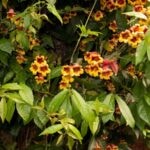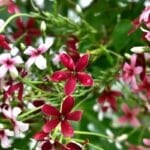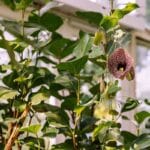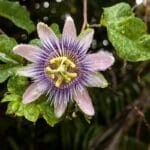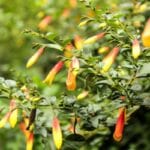Walking through a landscape with your senses being tickled is a relaxing and enjoyable experience for most of us. As we enjoy the space with fresh air and beautiful scenery, an additional aromatic level up the experience.
To achieve such an experience, Honeysuckles (Lonicera) is the perfect vine to grow. It gives off sweet scents and beautiful showy flowers.
Botanical Information
The Honeysuckles or Lonicera spp. is composed of a wide range of species and varieties. Due to this vast selection of variety and species, more options are available to find the most suitable for any landscape.
Coming from the Caprifoliaceae family, this genus is a collection of evergreen shrubs and vines. Identification of the invasive and non-invasive species will require a piece of in-depth knowledge about them due to the proliferation of various hybrids, varieties, and species present.
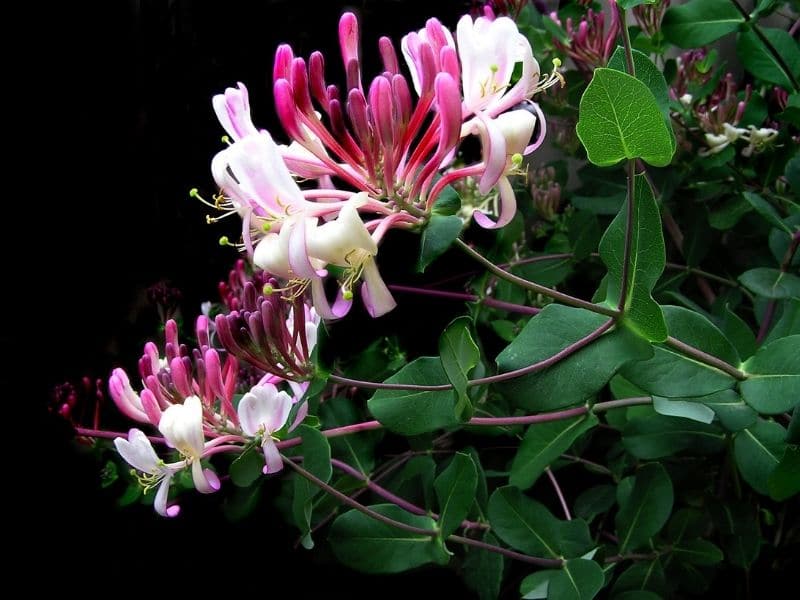
Spatial Distribution
Generally, the Honeysuckle vine was introduced to America from the different countries of Asia. In 1752, bush honeysuckles were documented to be brought to North America to serve as ornamentals.
According to Thomas Jefferson’s journal entry, he took care of Honeysuckles in his place in Monticello where they grew outside the perimeters of his landscape into the woods.
Presently, the Honeysuckle vine is best grown in USDA zones 4 to 9. In some areas, different species and hybrids are recorded as invasive or aggressive.
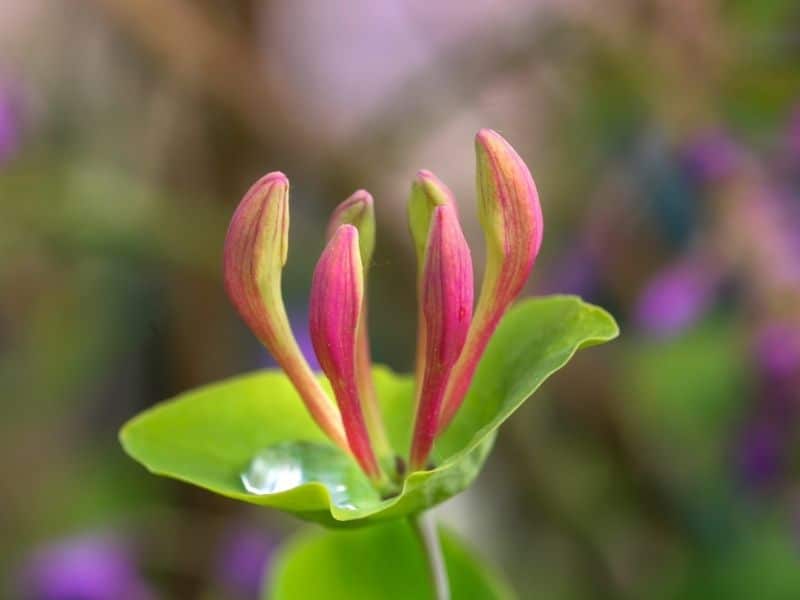
Leaves
Mostly, Honeysuckle vines give rise to leaves that vary in shade, it is often blue-green, but there are also some deep green and copper brown colors for some cultivars. Also, their leaf shape and arrangement are commonly oval and opposite respectively.
In some cases, the leaves form a cup-like structure surrounding their stem. Their margin is smooth and tapered on the apical parts of the leaf.
In identifying invasive types of Honeysuckles, their stems are hollow which is different from the Native ones.
Honeysuckle Flower
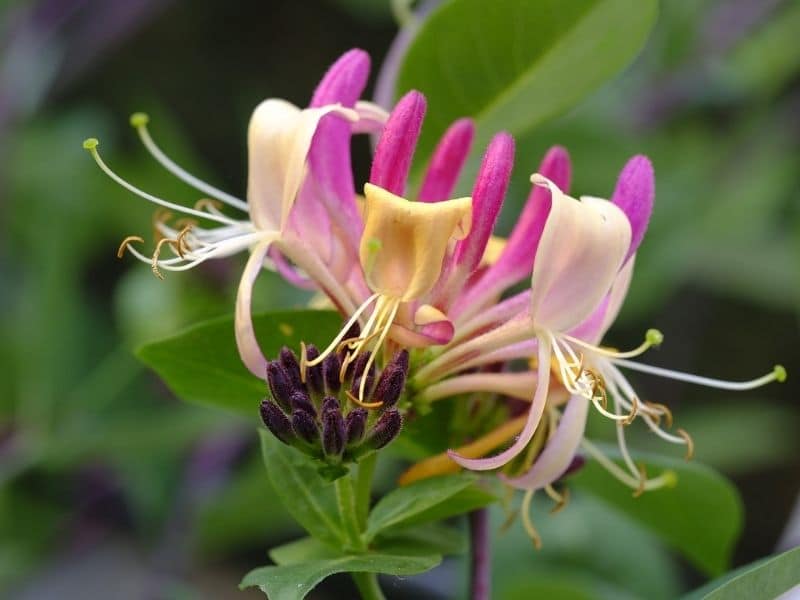
Flowers of Honeysuckle vines are seen on the apex of stems in a conglomeration of 2 to 5. Each flower has a long tubular calyx with a double-lipped corolla wherein the upper lip has four short erect lobes while the lower lip only has one cupped lobed.
Also, 5 stamens and a style with a coarse stigma protrude. Honeysuckle flowers come in different colors either red, pink, or white but most are fragrant. During May and June, this plant blooms, and it may last for 2 to 3 weeks.
Fruit and Seeds
After they showcase their fragrant flowers, it is replaced by fruits that are either red or yellow, succulent and are somewhat oval. They are usually 5 to 7 millimeters long upon maturity and develop in pairs at the basal part of the leaves. Their fruits are often seen in pairs located at the basal part of the leaves from July up to September.
When the seeds are dispersed, cold and moist conditions are favorable for breaking the dormancy.
Growth Habits
Honeysuckle plant is one of those aggressively growing vines that can survive anywhere. Climbing honeysuckle types are often hindered only by the existence of supporting structures but even in cases like that, they look for areas to grow.
Due to this growth habit, they pose a potential threat in the landscape by inhibiting the growth of other existing vegetation by shading and nutrient competition. To prevent such a disaster in the landscape, follow the right growing and care tips for Honeysuckles.
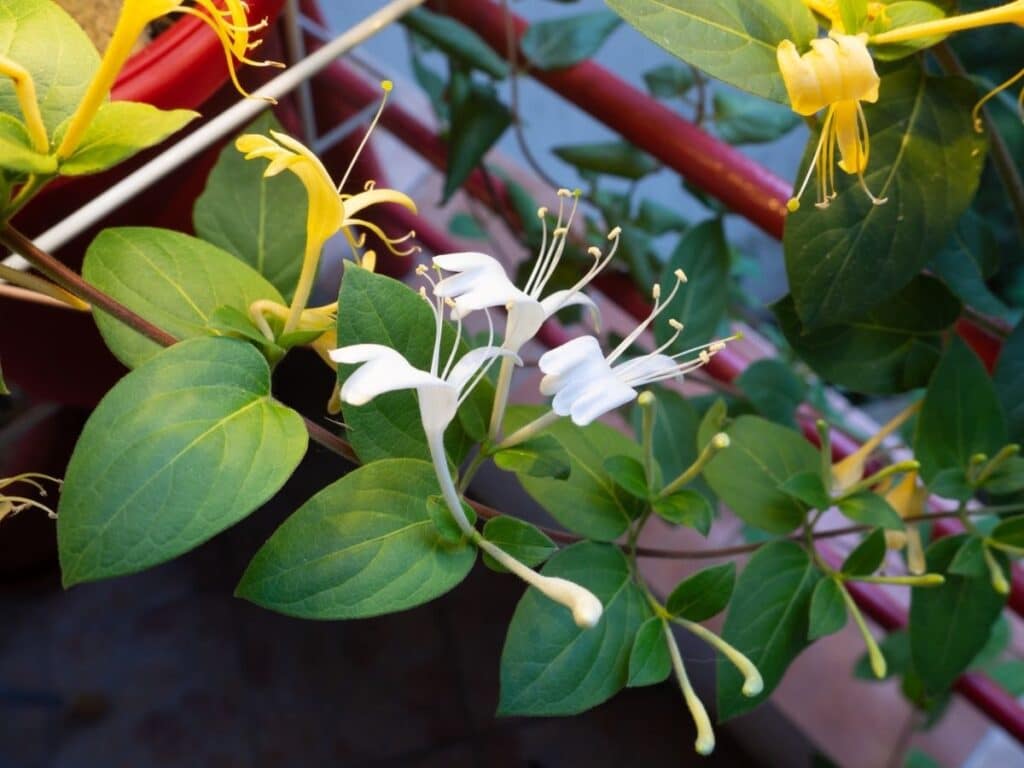
Growing and Care Tips
Sun Requirement
Honeysuckle vines are sun-loving plants, but they tolerate partial shade. In areas wherein partial shade is only given to the plant, it lowers the possibility of flower production.
Water Requirement
This vine does not need a lot of water and is drought tolerant. Watering should be scheduled to keep the soil moist. Regularly check the status of the soil and the Honeysuckle plants to know when to adjust the watering program. During summer and hot dry days, more frequent watering and application of mulch for moisture retention are recommended.
Temperature and Humidity
As a sun-loving plant, Honeysuckle vines. Tolerates high temperatures.
Soil Requirement
Honeysuckles are aggressive and survive on different types of soil. However, planting them in well-drained and moist media will optimize their growth.
Growers use soil mixtures containing loam, sand, and other soil aggregates like pebbles or rocks that will increase the medium’s porosity. Ask local garden supply stores about the mixtures available and their benefits to see if it is the right media for this plant.
Fertilizer Requirement
Organic matter-rich soil is enough for this plant to flourish. Application of fertilizer is not necessarily needed unless symptoms of nutrient deficiency show.
Furthermore, giving the plant the right amounts of a balanced fertilizer will encourage blooming growth in general. Although, nitrogen-rich fertilizers will favor foliage formation and might hinder flower production. On the other hand, phosphorus fertilizers may be used to favor flowering.
Maintenance Activities
Indeed, Honeysuckles thrive almost anywhere they are planted. This trait has its pros and cons. It is good that Honeysuckles require minimal alterations for growth but letting it grow without supervision may result in disarray.
There are growers who would let their plants grow naturally, wherever they desire to go. However, for those who want to keep their plants in check and keep a form and shape that is aesthetically pleasing for them, some maintenance activities should be performed.
The main thing that should be present to keep this vine trained is the supporting fixtures. The existence of such installations, while the plant is young or even before it is planted, will lessen the possibility of root damage.
Then, regular pruning should be done especially for mature and fully-established plants. As they mature, the older stems turn woody, especially on the basal parts of the Honeysuckle. In this case, rejuvenative pruning or cutting back will promote new sprouts.
Moreover, pruning may also be done after flowering. Even though flowers may grow on the same spots as last season’s growth, it would be better to thin out and remove dead branches and dried parts to make the plant more aesthetically pleasing and less susceptible to diseases.
Propagation
The best time to grow Honeysuckle is during the early spring. Propagation may be done through seeds, leaf bud cuttings, and layering. Seed dispersal through wind and water is the most common way of reproduction for Honeysuckles.
The seeds, however, need cold stratification to help in the germination process and break dormancy. If sowing the seeds is manually done, make sure to put them in cool moist areas.
For layering, choose a stem that is mature but flexible enough to be bent. Around 5 to 10 inches away from the tip of the stem is the part of the shoot that should be pinned down and covered, leaving the tip exposed above the soil.
When new shoots develop, a trellis or a bamboo pole should be placed as a guide and anchorage for the growing plant.
For leaf bud cuttings, choose the right material to cut by picking a stem with a pair of leaves. Cut it below midway between the lower node. Dipping the lower tip in rooting hormones will help inhibit root formation faster.
Also, it is imperative that cuttings should be kept in a warm room and enough moisture should be supplied. Transplanting may be done once the shoot has developed a stable root system, more leaves, and a stable stem.
In all these techniques, well-drained and moist soil should be provided. Avoid water logging as it may cause root rot and damage your seedlings.
Common pests and diseases of honeysuckle include aphids, spider mites, powdery mildew, and leaf spot diseases. The honeysuckle aphid causes distorted growth, while spider mites lead to stippling on leaves. Powdery mildew results in white powdery growth, and leaf spot diseases cause brown spots. Regular monitoring and treatment are essential for management.
Gardener’s Pick for Best Types of Honeysuckles
Orange Trumpet Honeysuckle
L. close is the species that is perfect for growing in cool areas. It can tolerate shade and produce orange flowers with a yellow undertone and blooms during May and June. At the fruit set, bright red berries are produced which attracts pollinators such as birds. This species is a native of the Pacific Northwest.
Common Honeysuckle
L. periclymenum is the scientific name of this species. It is loved by many due to its flowers’ sweet scent, which is prominent early in the morning and late at night. Thin white flowers that turn light yellow with lavender or pink pigments give rise to this sweet scent.
Goldflame Honeysuckle
L. x heckrottii is another crowd favorite due to its long flowering period that can last for the whole summer and larger and more showy flowers.
In the early parts of flowering, crimson-colored buds are seen but later on, gives rise to flowers that have soft pink with light violet tones on the exterior part and golden yellow interiors. Despite its aesthetic qualities, it is listed as an invasive species in Illinois.
Coral Honeysuckle
L. sempervirens is also known as the trumpet honeysuckle or coral honeysuckle. This species is widely known to be flamboyant as it showcases its beauty by giving off bundles of flowers. Each flower has a brick-red exterior with a striking yellow throat inside.
Due to its trumpet-like structure, this species’ flowers tend to be more attractive to hummingbirds. Hence, expect some feathered visitors in your landscape.
Brown’s Honeysuckle
L x brownii is also called the Scarlet Trumpet Honeysuckle. This hybrid is a mixture of L. sempervirens and L. hirsuta. Thanks to the latter, it can withstand cold weather conditions. In addition, this combination gave rise to a lightly scented scarlet flower-bearing vine that blooms from late spring up to October.
Japanese honeysuckle
Japanese honeysuckle (Lonicera japonica) is a popular choice for gardeners due to its fragrant blooms and vigorous growth habit. This twining vine produces clusters of sweetly scented, white or yellow flowers that attract pollinators.
With its long blooming period and easy maintenance, it’s a top pick for adding beauty and fragrance to gardens.
Function In The Landscape
Honeysuckles is a versatile plant that may be used as a screen or specimen. For privacy purposes, Honeysuckles may be trained to cling to fences and trellises.
The supporting infrastructures, where this vine twines, is the limiting factor for its growth and form. However, this plant is left to dangle or crawl down in some landscapes.
Furthermore, in optimizing its fragrance, it can be grown together with other flowering vines and shrubs that complement its scent.
Potential Harm
Invasive species of Honeysuckles will pose a potential threat to the existing vegetation in a landscape. As it dominates space, it also disrupts the ecosystem. Some food resources for wildlife may decrease in number, if not completely gone. This is why in taking care of honeysuckles it is important to know the type and to keep it in control.
In areas where the population of Honeysuckle is still low, mechanical control may be done by hand-weeding and cutting. If the situation progresses and the Honeysuckles becomes more disruptive, chemical control is advisable.
Keep in mind to choose the right chemicals and apply them as directed. Instructions for pesticides are seen in the label or product boxes.
If this potential threat makes you doubt about using Honeysuckles in your garden, alternative vines may be used. Some recommended alternatives are Woodbine (Clematis virginiana), Virginia Creeper (Parthenocissus quinquefolia), and Wild Clematis (Clematis pitcheri).
FAQs
Do honeysuckles like sun or shade?
Honeysuckles generally prefer full sun to partial shade. While they can tolerate some shade, they typically bloom more profusely in full sun.
How do you keep honeysuckle blooming?
To keep honeysuckle blooming, provide it with adequate sunlight, water, and nutrients. Regular pruning can also help promote flowering by removing old or spent blooms and encouraging new growth.
Where does honeysuckle grow best?
Honeysuckle grows best in well drained soil with moderate moisture levels. It thrives in a variety of environments, including gardens, landscapes, and natural areas, and can be grown as a vine, shrub, or ground cover, depending on the species and cultivar.
Is honeysuckle easy to grow?
Yes, Honeysuckle is generally considered easy to grow, particularly in favorable conditions. It is adaptable to a range of soil types and climates, and many varieties are relatively low-maintenance once established. However, some species may be more invasive than others, so it’s important to choose cultivars that are suited to your specific growing conditions and to keep them in check if they show signs of spreading aggressively.
Up next: Honeysuckle Flower Meaning and Symbolism
*image by Trimitrius/depositphotos

